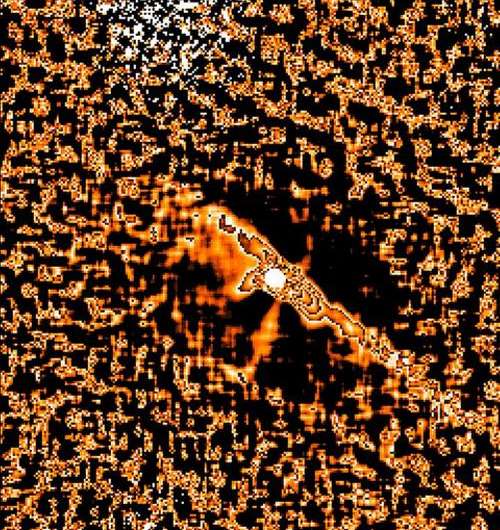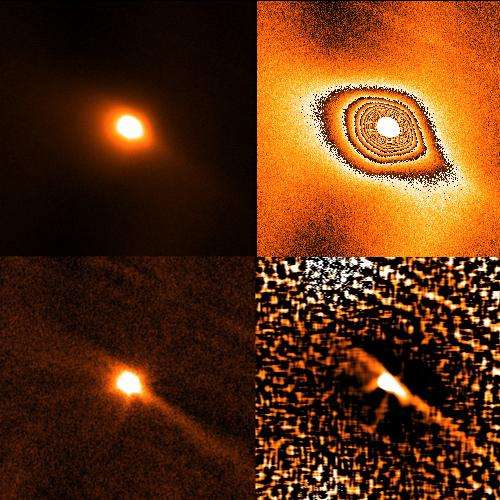Image of 67P/Churyumov-Gerasimenko acquired in February 2009, processed using a numerical filter. Structures visible in the image are signatures of regions of enhanced activity on the nucleus surface. Credit: J-B Vincent/MPS/GP Tozzi/L Lara/Z-Y Lin
After a journey of almost ten years, the Rosetta mission has just a few months left to wait before beginning its rendezvous with a time capsule. Comet 67P/Churymov-Gerasimenko is a dirty snowball of ice and dust that preserves material from the formation of the Solar System 4.5 billion years ago. During 2014, the European Space Agency's most ambitious mission to date will both start to orbit the comet's nucleus and deploy a small laboratory of scientific instruments, Philae, to dock with the comet's surface. To aid Rosetta in safely achieving its task, an international group of scientists back on Earth are using ground-based telescopes and computer models to understand the behaviour of the comet as it approaches the Sun and begins to form its tail. Their findings have been presented this week at the European Planetary Science Congress (EPSC) 2013 at University College London.
"For two or three orbits now, our community has been observing the comet to determine the shape of the nucleus, the angle at which it spins on its axis and how its activity varies as it orbits the Sun. All of this information is vital for the planning of Rosetta's orbit and Philae's delivery," said Jessica Agarwal of the Max Planck Institute for Solar System Research (MPS).
"At this meeting, we have discussed everything from the make-up of the surface layer of the nucleus to the dust production rates, size and velocity of the particles emitted, the way the comet interacts with the solar magnetic environment… There are a lot of things we need to know!" added Matt Taylor, ESA's Project Scientist for the Rosetta Mission.
Jean-Baptiste Vincent (MPS) has used images and modelling to study the development of gas jets as the comet becomes active. "We need to understand the formation and evolution of dust coma structures at all scales: from tiny filaments only visible close to the surface of the nucleus, to large structures extending tens of thousands of kilometres in the coma. Comet 67P appears to behave in a very consistent way, at least over the last two orbits. The southern hemisphere is more active than the northern and there are three major active regions from where gas jets evolve, which can eject dust particles at around 50 kilometres per hour."
Image acquired between June 2008 and Feburary 2009. The location of the dust coma structures are enhanced by different filtering techniques ((1-3) adaptive Laplace-filtered images, (4) adaptive Laplace-filtered image with the structure geometry indicated by annotations and (5) dashed lines, (6) Larson-Sekanina filtered image). Credit: J-B Vincent/MPS/GP Tozzi/L Lara/Z-Y Lin http://www.europlanet-eu.org/images/stories/epsc2013/rosetta_67p-evolution.jpg Dust coma of 67P at a distance of 187 million kilometres from the Sun, shortly before the comet’s closest approach. Image acquired on 18 Feb. 2009. The image (top left) is presented as processed through various numerical filters to enhance the visibility of the jets. Credit: J-B Vincent/MPS/GP Tozzi/L Lara/Z-Y Lin
To safeguard the spacecraft during its long, cold journey through deep space, Rosetta was placed into hibernation in 2011. Research by a group led by Colin Snodgrass and Cecilia Tubiana of MPS suggests that 67P will start emitting gas and dust by March 2014, earlier than expected and just two months after the spacecraft receives its wakeup call on Monday 20 January 2014.
The scientists have based their predictions on 31 sets of images showing the comet at different points during its orbit. The images were recorded between 1995 and 2010 with telescopes including the Very Large Telescope (VLT) at the European Southern Observatory (ESO). By subtracting successive images to remove the starry background and making the comet stand out, they were able to study changes in brightness and hence the activity levels of the comet was at different points in its orbit.
"For the first time, we have a meaningful comparison of all data sets so that we can reconstruct the activity of the comet as it moves around the Sun," said Snodgrass. "The results were something of a surprise."
Scientists had estimated that the comet would start to form is tail at distance of around 450 million kilometres from the Sun, when it would become warm enough for water ice to sublimate. Instead, it became active much further out—at 650 million kilometres.
"Water will still be frozen solid at that distance from the Sun. Some other gas must be responsible for this earlier activity that we've observed," said Tubiana.
Provided by European Planetary Science Congress

























